1. Overview
Jamini Roy was a highly influential Indian painter, celebrated for his pivotal role in modern Indian art. Born in 1887, he embarked on an artistic journey that saw him initially trained in Western academic traditions, only to consciously reject them in favor of developing a unique style rooted in Indian folk and tribal art. This shift was driven by a deep commitment to cultural heritage and a desire to make art accessible to the masses, giving voice to the ordinary people of India. Honored with the Padma Bhushan by the Government of India in 1954, Roy remains one of the most distinguished pupils of Abanindranath Tagore and is recognized as one of India's "Nine Masters." His distinctive style, characterized by simplified forms, bold lines, and a flattened perspective, drew inspiration from indigenous sources like Kalighat painting, leaving a lasting impact on subsequent generations of Indian artists.
2. Early Life and Background
Jamini Roy's early life and education laid the foundation for his artistic career, though he would later consciously diverge from his initial Western academic training to embrace indigenous art forms.
2.1. Childhood and Education
Jamini Roy was born on April 11, 1887, in the village of Beliatore in the Bankura district of West Bengal. He hailed from a moderately prosperous Kayastha family of land-owners, growing up in a middle-class household that fostered a love for art, which significantly influenced his future choices. At the age of sixteen, Roy was sent to study at the Government College of Art, Kolkata. During his time there, Abanindranath Tagore, the founder of the influential Bengal School of Art, served as the institution's vice-principal. Roy was trained in the prevailing academic tradition, focusing on drawing classical nudes and painting in oils. He successfully completed his studies, receiving his Diploma in Fine Art in 1908.
2.2. Transition to Indigenous Art
After graduating, Roy began his professional career as a commissioned portrait painter. However, in the early 1920s, he abruptly abandoned this path, driven by a profound need to discover his own artistic voice and move away from Western artistic influences. A decisive lecture by Rabindranath Tagore and the influence of E.B. Havell, the principal of the Government College of Art, led him to the realization that his inspiration should stem from his own cultural roots. Consequently, he turned to the vibrant living folk and tribal art of India for guidance. He was particularly influenced by the Kalighat Pat style, known for its bold, sweeping brush-strokes and thick, cutting lines. Between 1921 and 1924, Roy initiated his first period of artistic experimentation, moving away from his earlier impressionist landscapes and portraits, with the Santhal dance serving as a significant starting point for his new artistic direction.
3. Artistic Style and Philosophy
Jamini Roy's artistic style underwent a significant evolution, moving from conventional Western academicism to a unique idiom deeply rooted in Bengali folk traditions. His philosophy emphasized social relevance, cultural identity, and accessibility for the common people.
3.1. Development of Style
Roy began his career primarily as a commissioned portrait painter, a conventional path for artists trained in Western academic traditions. However, in the early 1920s, he made a decisive break from this practice to embark on a quest to define his unique artistic identity. He consciously shifted his style away from his academic Western training, adopting a new approach based on Bengali folk traditions. Roy was remarkably prolific, sometimes referred to as an "art machine," producing an estimated 20,000 paintings throughout his lifetime, averaging about ten paintings per day. Despite this high volume, he consistently maintained his core artistic aims and vision across his extensive body of work. His signature style became characterized by simplification, flattening of forms, and the use of bold, clear outlines, often reminiscent of European modern art but distinctly Indian in its thematic and aesthetic origins.
3.2. Techniques and Materials
In line with his artistic philosophy of returning to indigenous roots, Jamini Roy deliberately chose to work with traditional and locally sourced materials. He frequently used indigenous pigments such as lamp black, organic tempera, and various earth and mineral pigments. This choice not only connected his art to the land but also made it more accessible and authentic to the folk traditions he admired. His distinctive approach to brushwork involved bold, sweeping strokes, often creating strong, defined lines that contributed to the flattened, graphic quality of his paintings. His use of color was equally deliberate, often reduced in number and applied with restraint, yet each hue carried significant meaning and purpose within the composition.
3.3. Artistic Vision and Social Impact
Jamini Roy's artistic vision was driven by a threefold quest: to capture the essence of simplicity embodied in the life of folk people, to make art accessible to a wider section of society, and to forge a distinct identity for Indian art. He firmly believed that art should not be confined to the elite but should resonate with and be appreciated by ordinary people. He aimed his art primarily at the ordinary middle class, considering them the true upholders of art, even though his work also attracted the wealthy. Roy held strong critical views, asserting that common people were more important than governments because they represented the authentic voice of his art. This commitment to social inclusion and cultural authenticity was central to his practice. He even preferred to be called a "patua," identifying with the traditional folk artists of Bengal who painted narrative scrolls and images for the masses.
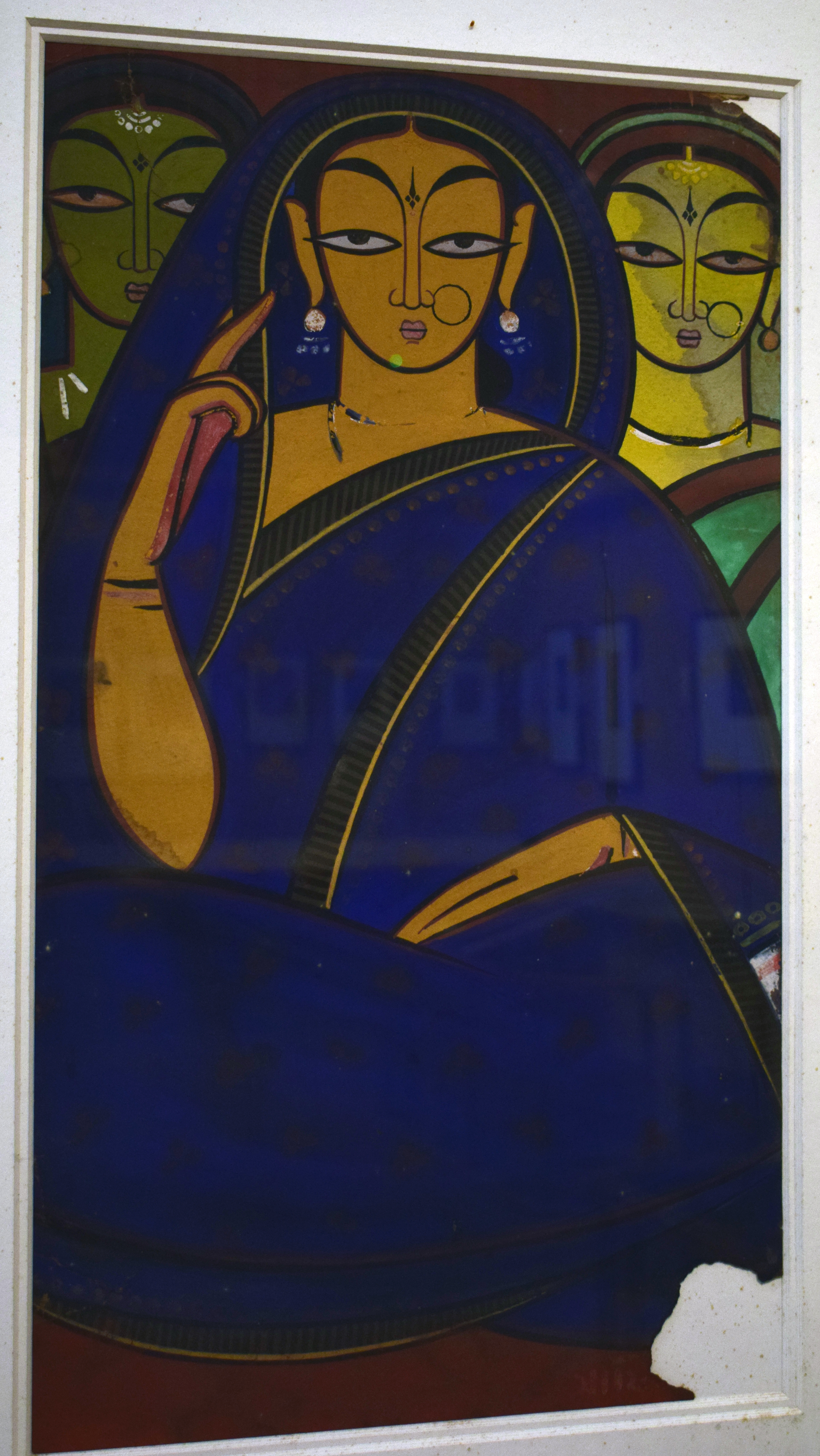
4. Major Works
Jamini Roy's body of work is extensive, with several key paintings and series standing out as significant representations of his artistic achievements and thematic concerns, often reflecting his dedication to indigenous styles and narratives.
4.1. Ramayana Series
One of Jamini Roy's most significant achievements is his "Ramayana" series, created in 1946. This magnum opus consists of 17 canvases, each measuring approximately 42 in (106 cm) by 30 in (76 cm). The series was patronized by Sarada Charan Das and executed in the distinct Kalighat pata style, utilizing natural colors derived from earth, chalk powder, and vegetable sources instead of chemical dyes. The narrative of his "Ramayana" begins with the sage Valmiki and concludes with Sita's aagnipariksha (trial by fire), bringing the story full circle back to Valmiki's hermitage. Each of the 17 canvases is frequently adorned with decorative flowers, landscapes, birds, and animals, characteristic of the Bengal School of Art. Roy's lines in this series are simple, bold, and roundish, initially inspired by clay images, yet they effectively convey complex moments and render subtle but powerful emotions. Today, the complete "Ramayana" series, along with eight other large-scale original works, is on display at Sarada Charan Das' residence, "Rossogolla Bhavan," in Kolkata, which houses the largest private collection of Jamini Roy's paintings, comprising 25 of the master's originals. Roy also created individual replicas capturing various moments from the entire series, some of which are preserved in the National Gallery of Modern Art of India and displayed in the Victoria Memorial Hall.
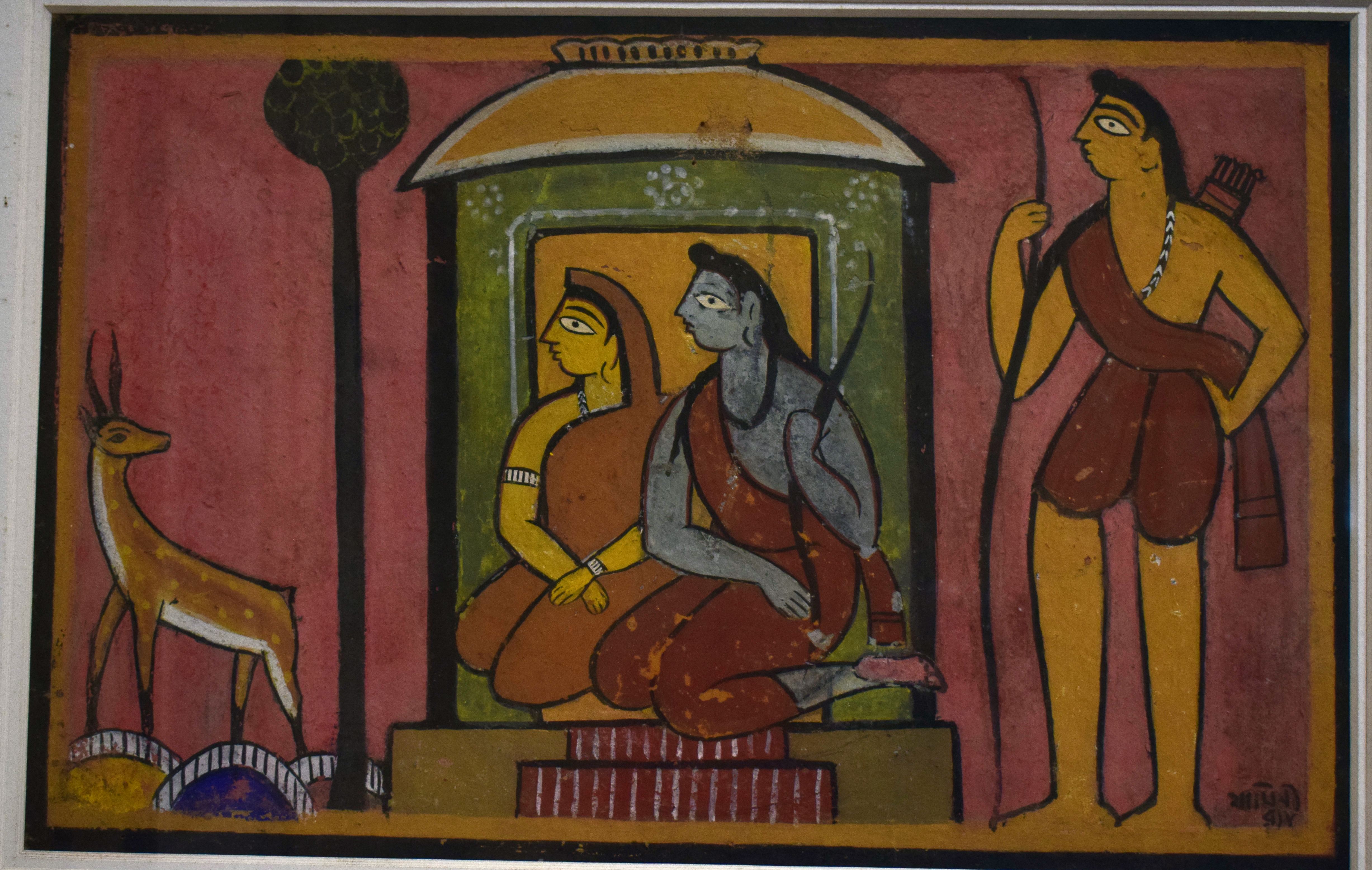
4.2. Other Notable Works
Beyond his monumental "Ramayana" series, Jamini Roy created numerous other significant works that exemplify his unique style and artistic intent. One such painting is "Bride and two Companions," created in 1952. This tempera on card measures 30 in (75 cm) by 15 in (39 cm). Art critic Coates noted the magnificent indigo color, typical of Bengal, and the red sandalpaste smeared on the bride's hands, highlighting that while Roy's choice of colors might appear purely decorative, "nearly every thing in his pictures has a reason and a meaning." The painting is characterized by its flatness and heavy outlining, portraying a traditional woman without artificial beauty or mythological background, thereby reflecting the strong folk-art inspiration that was present from the very beginning of his artistic shift.
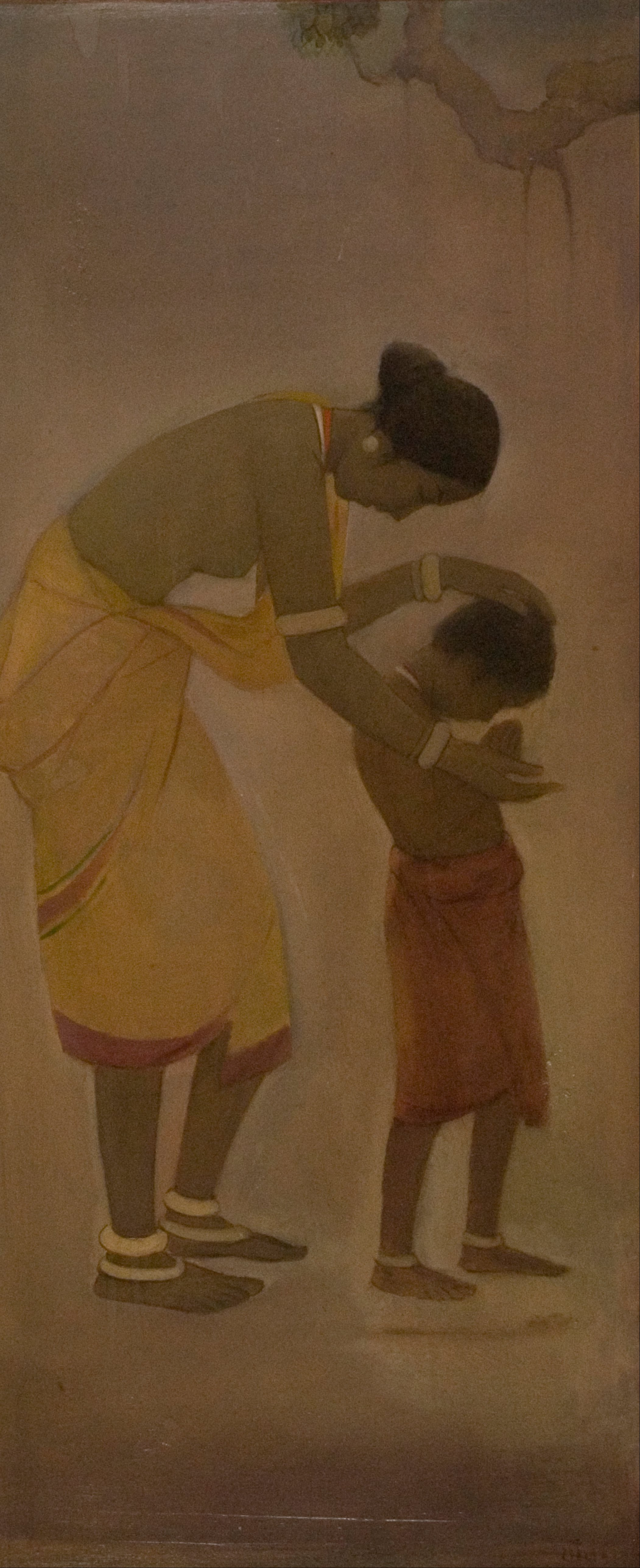
Another notable piece is "Dual Cats with one Crayfish," painted in 1968. This tempera on card measures 22 in (55.5 cm) by 17 in (44 cm). Coates described it as yet another new style for Roy, with colors reduced in number and very restrained, creating an almost overwhelming sense of formality. These works, among many others, demonstrate Roy's continuous experimentation and his consistent dedication to capturing the essence of Indian life and culture through his distinctive artistic language.
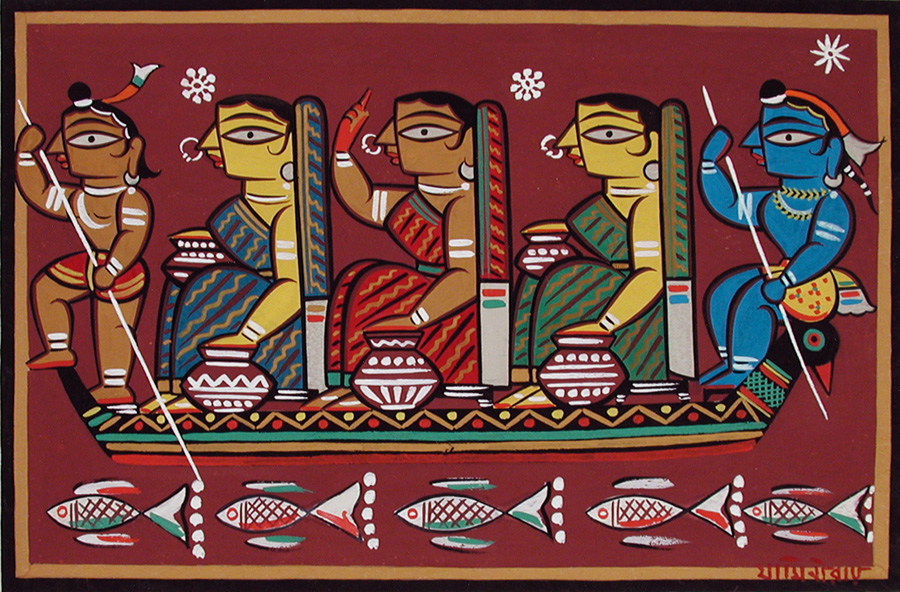
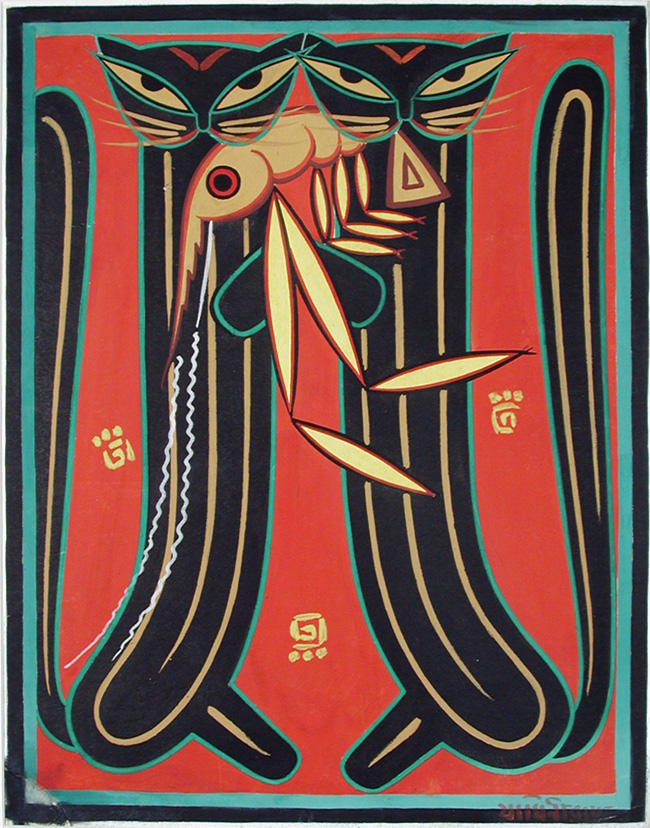
5. Exhibitions and Critical Reception
Jamini Roy's work gained significant recognition through various exhibitions both within India and internationally, attracting considerable critical attention that acknowledged his unique contribution to modern Indian art.
5.1. Exhibition History
Jamini Roy's paintings were first publicly exhibited in 1938 on British India Street in Kolkata (then Calcutta). His popularity soared throughout the 1940s, with the Bengali middle class and the European community emerging as his primary clientele, a testament to his aim of making art accessible to a broader audience. His work also garnered international exposure, being exhibited in London in 1946 and in New York City in 1953. Today, his art is held in numerous private and public collections worldwide, including the prestigious Victoria and Albert Museum in London. Roy spent the majority of his life living and working in Kolkata, where his artistic journey began with early experimentations with Kalighat paintings, eventually leading him to learn directly from village patuas, deeply influencing both his techniques and subject matter with traditional Bengali art forms.
5.2. Critical Evaluation
Jamini Roy's artistic journey and unique style received notable critical evaluation throughout his career. In 1929, during the inauguration of Roy's exhibition sponsored by Mukul Dey in Calcutta, Sir Alfred Watson, then Editor of The Statesman, delivered a significant address. Watson observed that Roy's work demonstrated the development of an artist constantly seeking his own mode of expression. He noted Roy's gradual departure from his earlier work, which was done under purely Western influence and largely consisted of small copies, to a style that was distinctly his own.
Watson highlighted Roy's "real endeavour to recover a national art that shall be free from the sophisticated tradition of other countries, which have had a continuous art history." He emphasized that the true significance of efforts to revive Indian art was often underestimated, and that revival did not simply mean a return to past methods, which would only create copyists without vision. Watson also stressed the importance of public encouragement for artists, stating that art cannot progress without it. He urged those with financial means to "buy Indian art with courage," acknowledging that while some acquisitions might be of little immediate worth, others could become highly valuable. By encouraging artists like Roy, who strove to give "a fresh expression to Indian thought" through line and color, Watson believed they were helping a movement destined to add new luster to the country. This critical perspective underscored Roy's pivotal role in shaping a modern Indian art identity distinct from Western influences.
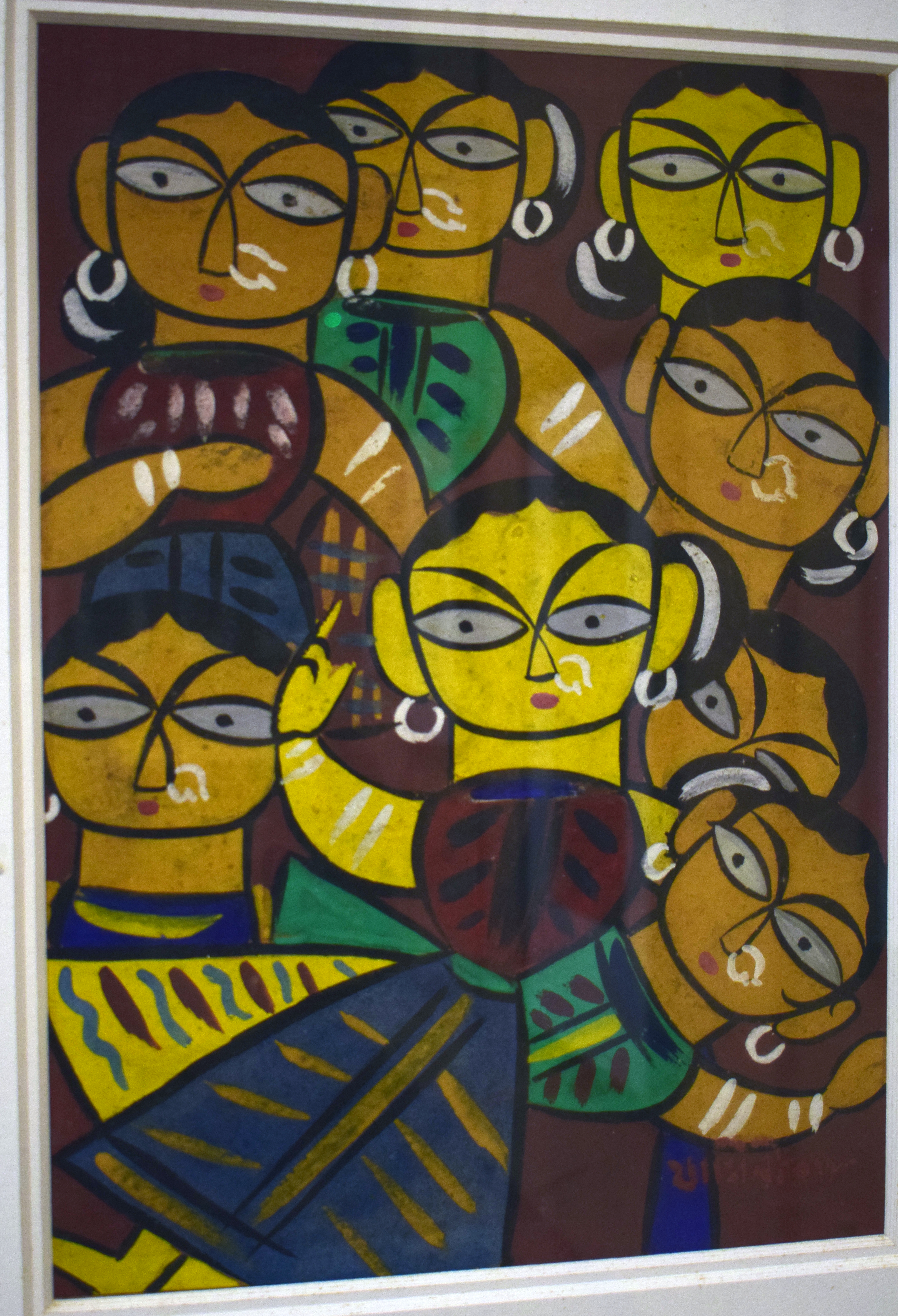
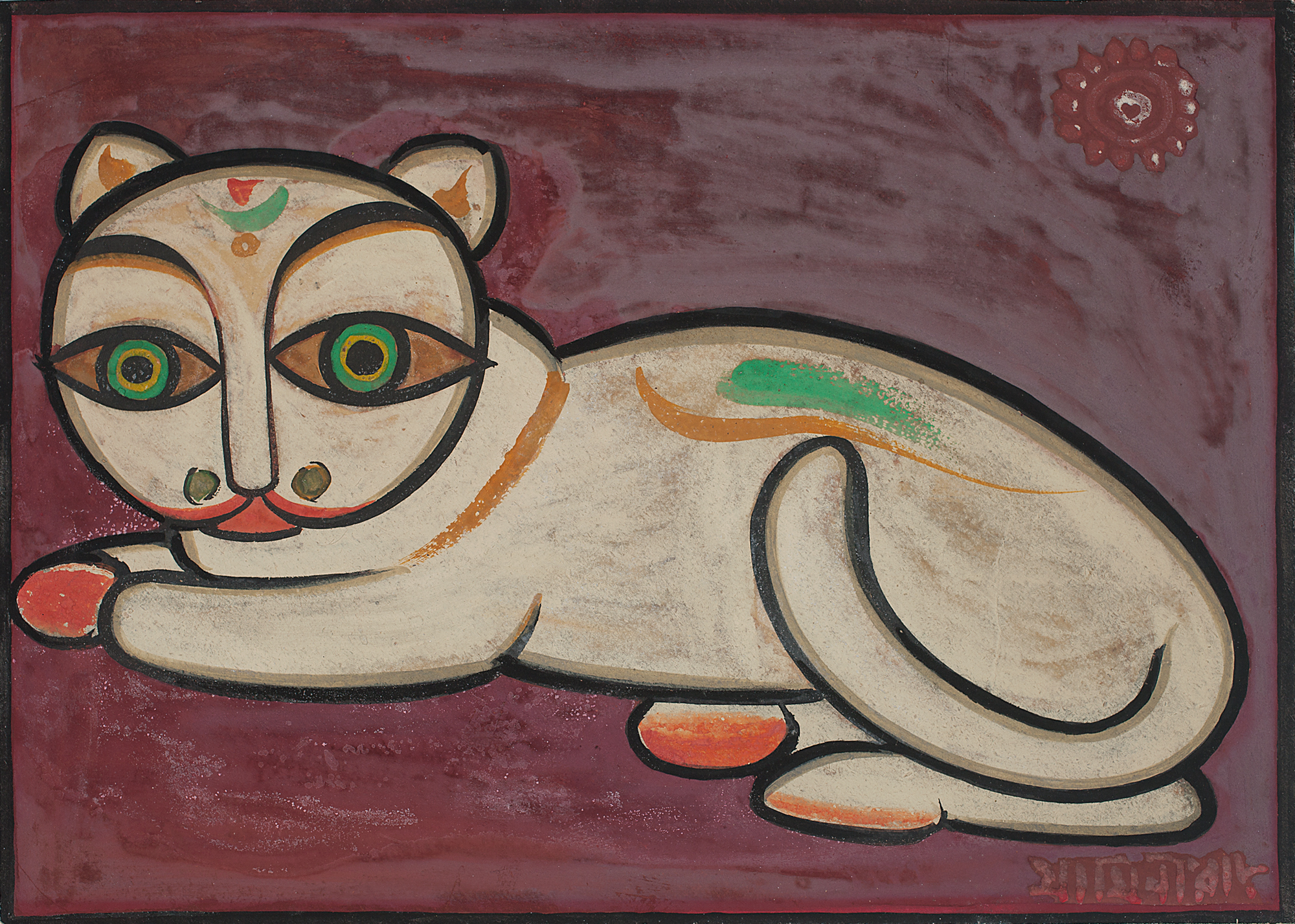
6. Awards and Honors
Jamini Roy's profound contributions to Indian art were recognized with several prestigious awards and honors throughout his distinguished career, acknowledging his significant role in shaping the modern art movement in India.
6.1. National and Artistic Accolades
In 1934, Jamini Roy received a Viceroy's gold medal at an all-India exhibition, an early recognition of his burgeoning talent. His most prominent national honor came in 1954 when the Government of India bestowed upon him the Padma Bhushan, which is the third-highest civilian award in India. Further cementing his legacy in the fine arts, in 1956, he was designated as the second Fellow of the Lalit Kala Akademi, the highest honor conferred by the Lalit Kala Akademi, India's National Academy of Art. These accolades underscore his national importance and his lasting impact on the artistic landscape of India.
7. Death and Legacy
Jamini Roy passed away in 1972, leaving behind an indelible legacy that continues to influence Indian art and culture. His work has received significant posthumous recognition, solidifying his status as a master of modern Indian painting.
7.1. Posthumous Recognition and Influence
Jamini Roy died on April 24, 1972. His enduring significance was formally acknowledged in 1976 when the Archaeological Survey of India, under the Ministry of Culture, Government of India, declared his works among the "Nine Masters." This designation signifies that his art, alongside that of other luminaries like Rabindranath Tagore and Amrita Sher-Gil, is considered an "art treasure" due to its artistic and aesthetic value. His contributions continue to be celebrated, as evidenced by Google Doodle dedicating a special doodle to him on April 11, 2017, to mark his 130th birthday. Roy's artistic philosophy and distinctive style have profoundly influenced subsequent generations of artists, inspiring a return to indigenous roots and a focus on making art accessible and reflective of common life. His successors, including his daughters-in-law and grandchildren, continue to reside in the home he built in Ballygunge Place, Kolkata, and his works are preserved and displayed in various museums and galleries across the globe, ensuring his lasting influence on the narrative of Indian art.